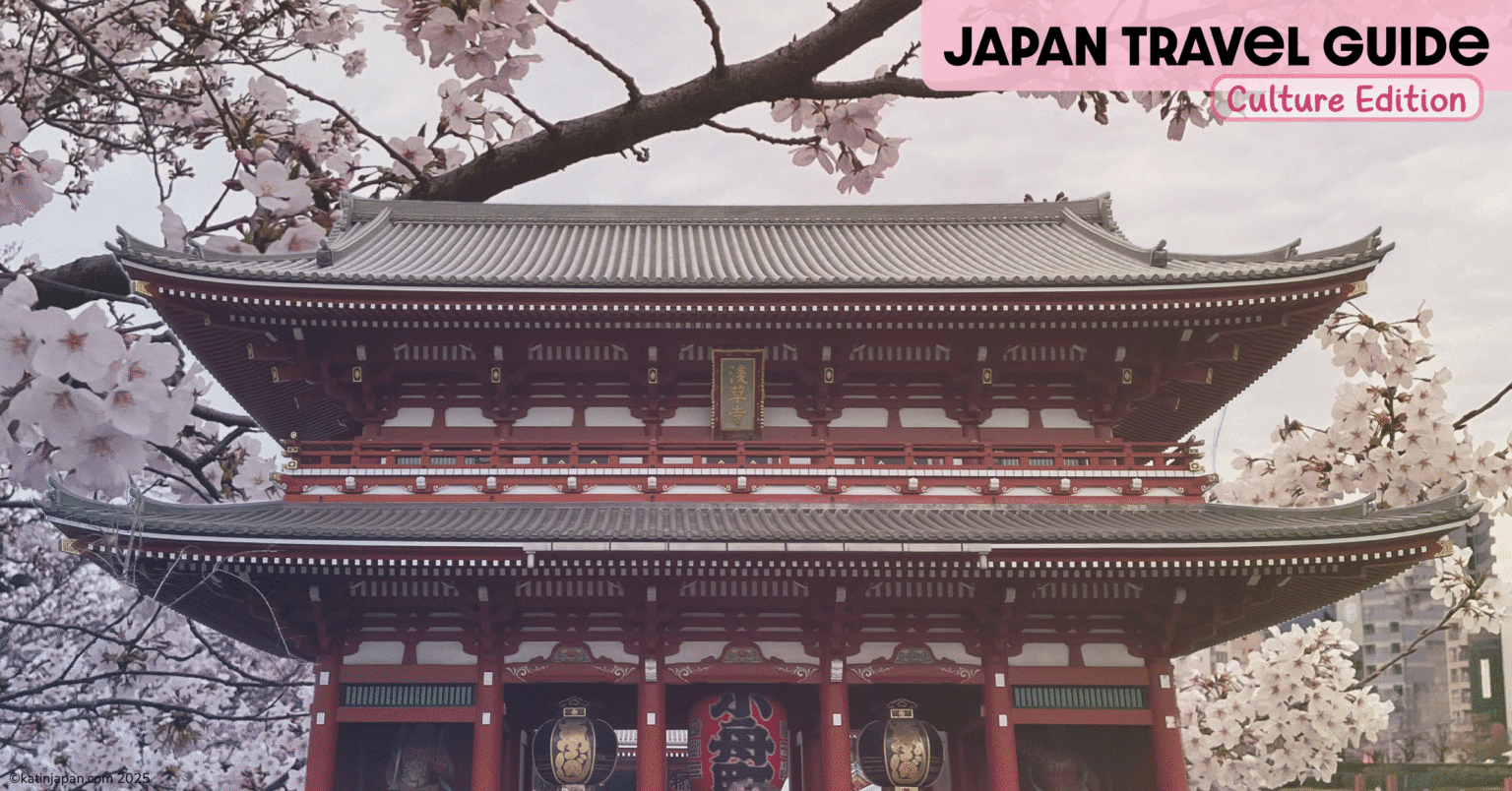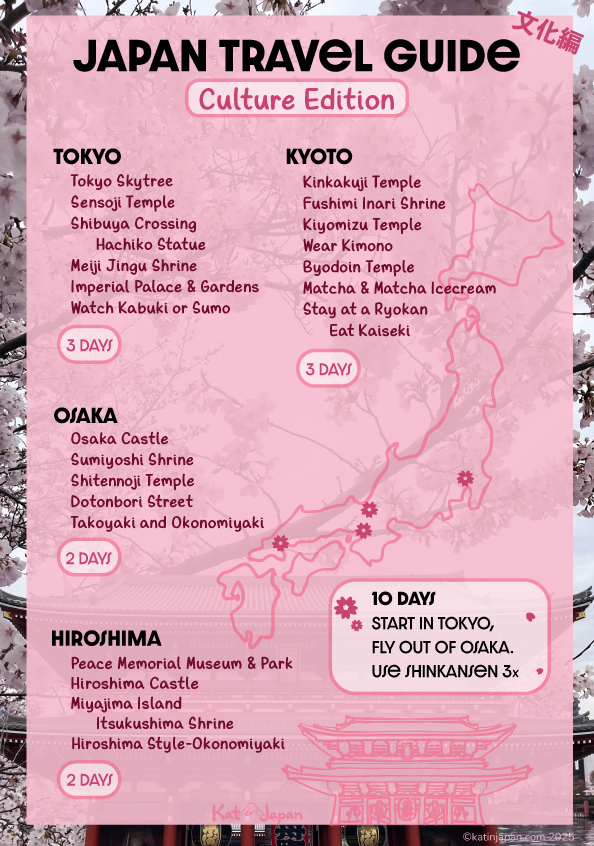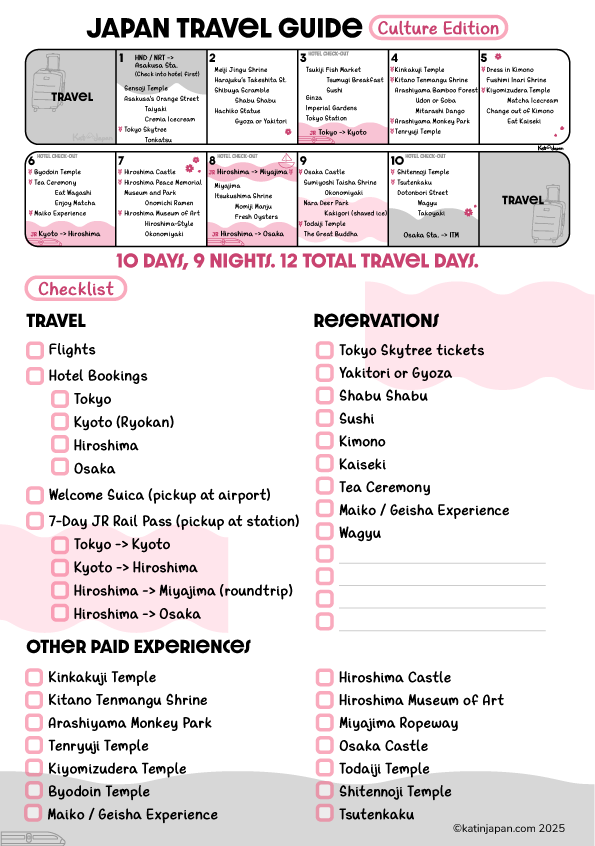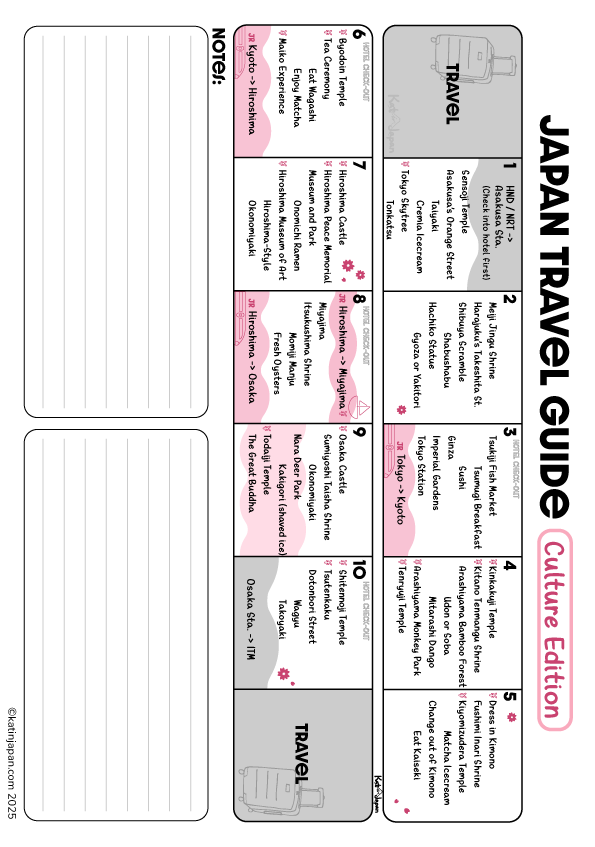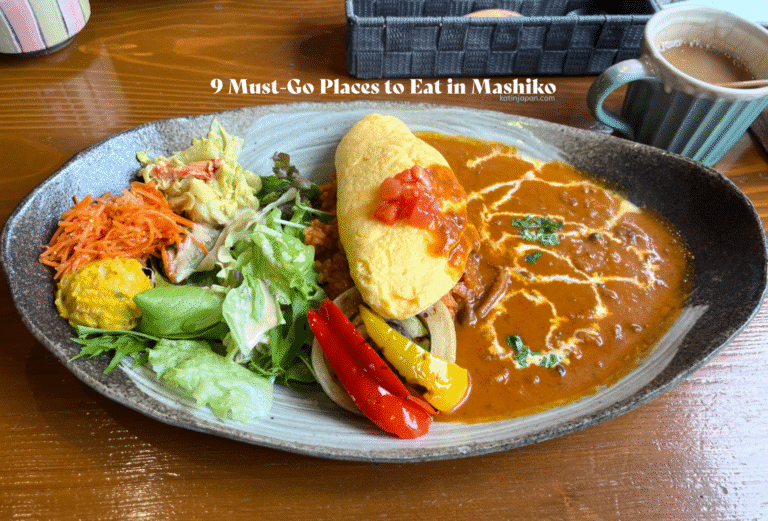Inspired by my own travel around Japan, take a 10-day culture tour around Tokyo, Kyoto, Osaka, and Hiroshima using my Japan Travel Guide. No matter the season, you can enjoy cultural touchstones of Japan with this guide.
Knowing what to do in a country as vibrant as Japan can be difficult, but my travel guide simplifies that. It includes major areas of cultural significance and general food recommendations based on each locale.
While my Japan travel guide covers ten jam-packed days of cultural sites and activities, the total travel time is 12 days. Yet even in a limited time, you can enjoy many of the wonders Japan has to offer.
Japan Travel Guide Overview

My Japan Travel Guide [Culture Edition] focuses on four major cities in Japan. It’s a 10 day, 9 night trip which covers 12 days including travel time.
This accounts for travel time; necessary if you’re flying from somewhere like the US or Europe.
It covers cultural landmarks like shrines and temples and the Hachiko statue in Shibuya, but also culturally relevant experiences like wearing Kimono and attending a Tea Ceremony in Kyoto.
This travel guide isn’t for the faint of heart. You’ll be walking, catching trains with luggage, and possibly even hiking through temple and imperial gardens.
If you’re looking for a slower pace, you can reduce the amount of landmarks. Other strategies include building in time to stop at cafes or restaurants, or stop to rest at public parks.
To lessen the burden on yourself, you can also opt for using only a carry-on bag or utilizing taxis and airport buses.
Even a slow-paced Japan Trip is chock-full of exciting experiences. If you have physical limitations, you can still enjoy your trip.
Download the Japan Travel Guide Checklist PDF
Using the Japan Travel Guide
Note: YEN to USD estimates and prices are based on rates at the time of writing and may vary.
This Japan Travel Guide gives you the outline to create your self-driven Japan Trip. Print it out and keep everything together as you plan.
Use the checklist to plan your preparations for travel, from flights to food reservations, and keep everything in one place. I recommend using a folder to keep everything together, then bring it to Japan with you.
You can keep notes of important information like your hotel addresses, or other things you want to do. You can even keep track of your trip expenses.
How the Guide Works
This guide focuses on using public transit methods like trains and bullet trains (Shinkansen 新幹線).
I personally dislike city buses despite how useful they may be, so I avoid adding them to the plan. If you don’t mind them, use them as you like.
However, you don’t have to follow it to a tee– you can take what you like and leave the rest. Or reference it when you don’t know what to do in a certain part of Japan.
If you prefer to book tour buses or group travel, I recommend using a separate travel service or agency and using their guidance.
Keep your Notes in One Place
You’ll book your flight, hotels, Shinkansen – more on that below – food, and experiences like tea ceremonies and maiko performances. Try to do this at least a month in advance
Then mark your progress on your printed Japan Travel Guide PDF!
Some experiences, like the Tokyo Skytree can only be booked one month in advance, so set a reminder on your calendar to book.
Shrines and temples don’t require reservations but may charge a fee for entry or during special seasons. For example, during hanami season there are typically extra fees to enter special gardens.
So, I marked the Japan Travel Guide Checklist and itinerary with a “¥” for paid experiences.
For tips on how to pack, check out my Quintessential Japan Packing List (and free PDF download).
You can get it automatically when you sign up for the Kat in Japan newsletter!
And don’t forget to read up on my guide to Traveling on a Budget in Japan to make the most of your cash.
While this travel guide isn’t budget-focused, you can use the principles of budget travel to have a fun and culturally enriching trip.

The JR Rail Pass

The JR Rail Pass costs ¥50000, approximately $350, for a 7-day pass. This is only for regular cars, but unless you value the extra leg space, booking a green car isn’t necessary.
And if you use it three times, you can achieve the best cost performance. Therefore, I’ve formulated this travel guide to use the Shinkansen at least three times.
You can book your rides on the JR Rail Pass website. Then pick up your pass at any major JR station like Ueno or Tokyo.
If you follow the guide, you’ll only need it from day 3. That’s why the 7 day pass is the best deal. The JR Rail Pass really shines when traveling long distances across Japan.
However, you can also use it to traverse JR lines within metropolitan Tokyo and Osaka. So, if you know how to navigate the Tokyo JR lines, then getting the 14 day pass can be useful.
However, if you use the metro (which isn’t covered), you’d be better off using a Welcome Suica while traveling within the city for the first 3 days.
So, if you decide on the 7-day pass, make its usable period from Day 3 to Day 8. This will cover your long distance rides from Tokyo to Kyoto, then Kyoto to Hiroshima, and back to Osaka from Hiroshima. It’ll even cover the ferry to Miyajima.
Day by Day Breakdown

Click to enlarge
We’re not counting travel days, so Day 1 begins on your arrival to Japan. If your flight comes in late at night to Japan, you may need to adjust this for yourself. In my experience, flights usually arrive to Japan in the afternoon.
Day 1 – Tokyo
Upon arrival, the first thing to do is get to your hotel and check in.
From there you can head to Asakusa station. This station puts you right by Sensoji Temple with its impressive Kaminarimon.
Grab lunch or dinner at one of the many shops along Asakusa’s Nakamise or Orange Street. Or make a 15 minute trek to Tonkatsu Sugita for its Bib Gourmand-rated Tonkatsu!

You can walk to Tokyo Skytree and its connecting mall, Solamachi. There you can view the Tokyo skyline from 350m (1148ft)!
The mall has a plethora of fun shops and restaurants if you get hungry. And you can rest on benches outdoors or try to grab a seat in their massage chairs.
By the way, if you like journaling or stamp-collecting, be sure to pick up a travel journal or planner like the Hobonichi techo. Then you can stick all of your ticket stubs inside. You can also easily stamp train, city, and cultural stamps inside.
For more to do here, check out my Best 10 things to in Asakusa!
Day 2 – Tokyo
On Day 2, get out early and head to Meiji Jingu Shrine. A Jingu (神宮) is a special shrine with close ties to the imperial palace.
Take the walking path to its famous shrine and admire the thatched roofs of structures within. Just bring bug spray if you’re visiting during summer.

From here, head to Harajuku station. You can quickly walk to Takeshita Street, and enjoy some Harajuku fashion and the insanely crowded main street.
Of course there are other shops and malls surrounding the central walkway. Grab a spiral potato or fruit tangulu snack while you walk.
Then catch the JR train to Shibuya to check out the scramble crossing. You can see the Hachiko statue and snap a photo. Shopping at the 109 mall and other shops is part of Shibuya’s charm.
Shibuya has great food, from yakitori to taiwanese-style hotpot. I recommend trying yakitori, gyoza, or shabu shabu here.

Day 3 – Tokyo
Day 3 is a partial travel day. You’ll start in Tokyo, and take the Shinkansen to end in Kyoto. You can store your luggage in a coin locker in Higashi-Ginza Station.
First, go to Tsukiji. This area borders Ginza, where you can get delicious Japanese style breakfast at Tsumugi.
By 9 am, you can start touring Tsukiji Outer Fish Market. There they have tons of interesting street food and wholesale products. Don’t forget to eat sushi here – it’s insanely fresh and delicious. Seriously some of the best sushi I’ve had.

Check out 7 more great things to do in Ginza to fill out your time waiting for your train.
When the time comes, head to Tokyo Station to catch your Shinkansen. Be sure to pick up your JR Rail Pass. You can admire the design of the building and walk its “Tokyo Station City“.
Now catch your train and head to Kyoto. Check into your next hotel.
Day 4 – Kyoto
For Day 4, make your way to Kinkakuji Temple. Unlike in Tokyo, most big shrines and temples in Kyoto require an entrance fee.
Kinkakuji is no exception, costing ¥500 (~$3.50) to enter. However, its golden pagoda and pristine gardens are worth the cost to see for yourself.

At Kitano Tenmangu Shrine, there is no entrance fee. However, to access the shrine museum and beautiful gardens costs ¥1000 for adults.
From here, make your way to Arashiyama’s bamboo forest. It’s like walking into a fairytale land, with stunning green bamboo creating patterns in the sky.
Make a stop at Arashiyama Monkey Park to watch and even feed the native monkeys. Then go to Tenryuji Temple and get a feel for the historic buildings and gardens there.
Recommended eats are udon or soba, and mitarashi dango – sweet and salty soy sauce rice cakes.

Day 5 – Kyoto
Day 5 starts with dressing in kimono. You may want to eat breakfast beforehand, though. Kimono are absolutely beautiful and taking photos in them can be breathtaking– literally.
Because kimono are traditional Japanese clothing, they aren’t the most comfortable, and walking long distances or in the heat may be a non-starter. Take this into consideration when booking.
Alternatively, yukata are more relaxed, but only suitable for summer.
Then go to Fushimi Inari Shrine to marvel at its ten thousand torii gates. You can even walk through them, though it is a bit of a hike.

Next up is Kiyomizudera Temple. It’s one of many gorgeous world heritage sites in Kyoto. You can even purify yourself with its flowing “pure water”.
While walking in Kyoto you’re bound to stumble upon more than one matcha icecream vendor. Almost all of it is delicious, though some are stronger than others.
If you come across snacks like salted cucumbers and shiso lemonade, they make fantastic street foods on a hot day.
After you change out of the kimono, you can eat Kaiseki dinner, aka Japanese Haute Cuisine. If you stay in a traditional Japanese Inn (旅館 ryokan), this may be provided. Otherwise there are many notable kaiseki restaurants within Kyoto.


Day 6 – Kyoto
Since Day 6 is another partial travel day, find a coin locker for your luggage near Kyoto Station.
Go to Byodoin Temple in Kyoto’s Uji city. Another world heritage site, Byodoin is famous for being the image engraved on the 10-yen coin.
Uji is well-renowned for its matcha tea. I highly recommend finding a tea ceremony to participate in. Tea ceremony plays a large role in Japanese culture, and its customs are still practiced today.

You can enjoy wagashi (和菓子), aka Japanese-style sweets, while sipping strong matcha tea. Some matcha companies like Wazuka Tea Plantation also offer tea-picking experiences.
It’s also where pro’s like my good friend, Jace, get their high quality matcha from. You can check out his matcha cart in RVA or learn more about his company, The Exit Plan if you’re looking for matcha in the US.
Lastly, in Kyoto, you have to see a Maiko or Geisha. Maiko are essentially geisha in training. They specialize in singing, playing instruments, dancing, playing games, and socializing.
At the end of the day, pick up your luggage and head to Hiroshima on the Shinkansen for the next leg.
Day 7 – Hiroshima
We start off in Hiroshima for Day 7. This day is centered around Hiroshima Castle and the Peace Memorial Museum.
First, you’ll start in Hiroshima Castle. This castle was rebuilt after the atomic bomb wiped it and most other structures out. Now you can tour its museum and castle town’s historic vibe and even try on samurai costumes.
You can stop for Onomichi Ramen, a staple ramen dish of Hiroshima. It’s characterized by its soy sauce-based broth and addition of dried sardines for rich flavor.
Then make your way to the Hiroshima Peace Memorial Museum. This museum is a sobering and serious look into the events immediately following the atomic bomb. This is a must-see for tourists, but especially Americans.

From there, you can witness the A-Bomb Dome, which was miraculously left undestroyed by the bomb. It’s a world heritage site, and a stark reminder of not only the damage done, but resilience of Hiroshima.
The surrounding park is a serene area in contrast to the contents of the museum. You can also tour the peace monuments, Peace Bell, and Sadako’s one-thousand paper cranes.
Next up is the Hiroshima Museum of Art, which hosts different exhibitions at any given time.
And you can’t end the day without trying Hiroshima-style Okonomiyaki. Restaurants in famous Okonomimura serve up huge, delicious portions of it. Distinct from Osaka-style, this version is carefully layered and contains pork belly and noodles.

Day 8 – Hiroshima
Day 8’s main attraction is Miyajima Island and it’s stunning Itsukushima Shrine. You’ll want to get your day started relatively early and drop off your luggage at Hiroshima Station before heading to the ferry.
The ferry to Miyajima starts its “great torii route” at about 9 am, where it passes directly by the shrine. You can use your JR pass for this, plus an additional visitor’s tax of ¥100.
Be aware that the ferry stops its great torii route after about 4 pm. Plus, many shops on the island close around 4 pm anyway.

Explore the island and its cute deer. As you walk along the pier you’ll come to Itsukushima Shrine. This shrine is a sight to behold during high tide, as it appears to float over the ocean. Then you can walk up close during low tide.
Take the Miyajima Ropeway up into the forest of Mt. Misen. It’s a gorgeous view all the way up amongst the Momiji (Japanese maples).
And while you’re on Miyajima you can’t ignore the fun and delicious food options. There are tons of street vendors selling everything from fried fish to soft serve ice cream. But there are two things that stand out: fresh oysters and the famed momiji manju.
Fresh oysters are a no-brainer for seafood lovers. For the less inclined though, try the maple flavored Japanese sweet called momiji manju. And don’t forget to bring some home as souvenirs!
At the end of this day, pick up your luggage and head to Osaka via Shinkansen for the last leg of the trip.
Day 9 – Osaka
Osaka is known for its scrumptious food scene, and relaxed atmosphere. People generally tend to be warmer in Osaka than in Tokyo and Kyoto.
For the start of Day 9, go to Osaka Castle. You can walk the grounds for free, but entering the castle is ¥600 (~$4.15). Try to arrive early since people line up out the door to tour inside.
Then you can see a view of the city from its 8th floor observation deck! If you have time, you can even step into the Osaka Castle Museum (for a fee of course).

Now head to Sumiyoshi Taisha shrine. It’s a sprawling shrine with many historical buildings with architecture pre-dating other asian influences.
In the afternoon, be sure to grab some takoyaki and okonomiyaki before heading to Nara. If you use a JR line, try using your JR rail pass. Head to the Nara Deer Park.
At the park, you can see and feed the local deer with special deer crackers. They’ll bow to you to get them, but they can be a little pushy.
From there, walk over to Todaiji temple. This temple is absolutely gorgeous. It is famous for its Great Buddha statue (大仏 daibutsu). It sits at a whopping 50 ft tall (1,498cm)!

Day 10 – Osaka
Since Day 10 is a travel day, take it easy and visit just a couple of key areas. Drop off your luggage at Osaka Station then start your last day!
Start off by visiting the Shitennoji Temple and its incredible stone torii gate.
Inside you can actually walk up the 5-story pagoda. Just be warned that it’s a lot of stairs. Pretty interesting to walk around in, though.
If you have extra time before going to the airport, you can check out the Tsutenkaku Tower in the Shinsekai area of Osaka. You can walk its festive streets and see tons of colorful architecture and restaurants.

Otherwise, head straight to Dotonbori Street for good eats and souvenir shopping. You can also see the Glico man and Dotonbori River. Don’t forget to snap a picture making the same pose!
For lunch, you can’t go wrong with wagyu. Since Osaka is close to Kobe, you can find delicious wagyu at a fairly good price.
And if you weren’t able to try Osaka-style Okonomiyaki the previous day, make sure to try it before you leave!
Head to Itami airport from Osaka Station. If you kept ticket stubs of shrines and experiences, now’s a great time put them into your travel journal or planner.
The Inspiration behind the Japan Travel Guide

This travel guide is inspired by trips in and around Japan that I’ve taken.
When I was in high school, I had the opportunity to visit Japan for 14 days, and it was an absolutely jam-packed adventure. I walked more than I’d ever done in my life.
My feet hurt every day, but I was so excited that I just got back up again. We had a whirlwind trip visiting Tokyo, Kyoto, Osaka, and Hiroshima. But on the way we also stopped briefly in areas like Hakone and Yokohama.
Then, during our study-abroad experience in Japan from 2017-2018, we took several cultural trips with our cohort.
With the expert planning skills of our coordinator, we visited shrines, temples, power spots, castles, and restaurants of all kinds. Looking back on those experiences, I’m once again energized by the history and culture of Japan.

Nowadays, we visit areas of Japan we have and haven’t been before. From Hokkaido to Nikko and Kinugawa, Sendai to Mt. Fuji.
Japan has bountiful natural and manmade features bolstered by a citizenry that values nature and community.
We’ve had the luck and luxury of visiting so much of Japan, and I want you all to experience it for yourselves. It’s such a unique country full of deep traditions and rich culture.

